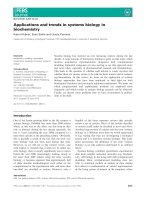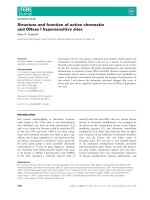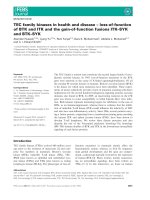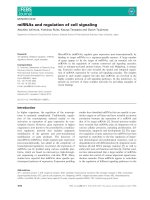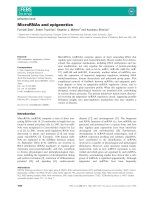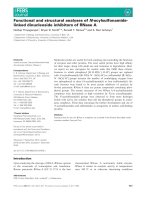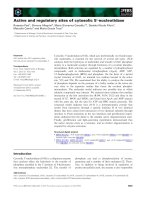Tài liệu Báo cáo khoa học: "Abstraction and Generalisation in Semantic Role Labels: PropBank, VerbNet or both?" doc
Bạn đang xem bản rút gọn của tài liệu. Xem và tải ngay bản đầy đủ của tài liệu tại đây (136.8 KB, 9 trang )
Proceedings of the 47th Annual Meeting of the ACL and the 4th IJCNLP of the AFNLP, pages 288–296,
Suntec, Singapore, 2-7 August 2009.
c
2009 ACL and AFNLP
Abstraction and Generalisation in Semantic Role Labels:
PropBank, VerbNet or both?
Paola Merlo
Linguistics Department
University of Geneva
5 Rue de Candolle, 1204 Geneva
Switzerland
Lonneke Van Der Plas
Linguistics Department
University of Geneva
5 Rue de Candolle, 1204 Geneva
Switzerland
Abstract
Semantic role labels are the representa-
tion of the grammatically relevant aspects
of a sentence meaning. Capturing the
nature and the number of semantic roles
in a sentence is therefore fundamental to
correctly describing the interface between
grammar and meaning. In this paper, we
compare two annotation schemes, Prop-
Bank and VerbNet, in a task-independent,
general way, analysing how well they fare
in capturing the linguistic generalisations
that are known to hold for semantic role
labels, and consequently how well they
grammaticalise aspects of meaning. We
show that VerbNet is more verb-specific
and better able to generalise to new seman-
tic role instances, while PropBank better
captures some of the structural constraints
among roles. We conclude that these two
resources should be used together, as they
are complementary.
1 Introduction
Most current approaches to language analysis as-
sume that the structure of a sentence depends on
the lexical semantics of the verb and of other pred-
icates in the sentence. It is also assumed that only
certain aspects of a sentence meaning are gram-
maticalised. Semantic role labels are the represen-
tation of the grammatically relevant aspects of a
sentence meaning.
Capturing the nature and the number of seman-
tic roles in a sentence is therefore fundamental
to correctly describe the interface between gram-
mar and meaning, and it is of paramount impor-
tance for all natural language processing (NLP)
applications that attempt to extract meaning rep-
resentations from analysed text, such as question-
answering systems or even machine translation.
The role of theories of semantic role lists is to
obtain a set of semantic roles that can apply to
any argument of any verb, to provide an unam-
biguous identifier of the grammatical roles of the
participants in the event described by the sentence
(Dowty, 1991). Starting from the first proposals
(Gruber, 1965; Fillmore, 1968; Jackendoff, 1972),
several approaches have been put forth, ranging
from a combination of very few roles to lists of
very fine-grained specificity. (See Levin and Rap-
paport Hovav (2005) for an exhaustive review).
In NLP, several proposals have been put forth in
recent years and adopted in the annotation of large
samples of text (Baker et al., 1998; Palmer et al.,
2005; Kipper, 2005; Loper et al., 2007). The an-
notated PropBank corpus, and therefore implicitly
its role labels inventory, has been largely adopted
in NLP because of its exhaustiveness and because
it is coupled with syntactic annotation, properties
that make it very attractive for the automatic learn-
ing of these roles and their further applications to
NLP tasks. However, the labelling choices made
by PropBank have recently come under scrutiny
(Zapirain et al., 2008; Loper et al., 2007; Yi et al.,
2007).
The annotation of PropBank labels has been
conceived in a two-tiered fashion. A first tier
assigns abstract labels such as ARG0 or ARG1,
while a separate annotation records the second-
tier, verb-sense specific meaning of these labels.
Labels ARG0 or ARG1 are assigned to the most
prominent argument in the sentence (ARG1 for
unaccusative verbs and ARG0 for all other verbs).
The other labels are assigned in the order of promi-
nence. So, while the same high-level labels are
used across verbs, they could have different mean-
ings for different verb senses. Researchers have
usually concentrated on the high-level annotation,
but as indicated in Yi et al. (2007), there is rea-
son to think that these labels do not generalise
across verbs, nor to unseen verbs or to novel verb
288
senses. Because the meaning of the role annota-
tion is verb-specific, there is also reason to think
that it fragments the data and creates data sparse-
ness, making automatic learning from examples
more difficult. These short-comings are more ap-
parent in the annotation of less prominent and less
frequent roles, marked by the ARG2 to ARG5 la-
bels.
Zapirain et al. (2008), Loper et al. (2007) and
Yi et al. (2007) investigated the ability of the Prop-
Bank role inventory to generalise compared to the
annotation in another semantic role list, proposed
in the electronic dictionary VerbNet. VerbNet la-
bels are assigned in a verb-class specific way and
have been devised to be more similar to the inven-
tories of thematic role lists usually proposed by
linguists. The results in these papers are conflict-
ing.
While Loper et al. (2007) and Yi et al. (2007)
show that augmenting PropBank labels with Verb-
Net labels increases generalisation of the less fre-
quent labels, such as ARG2, to new verbs and new
domains, they also show that PropBank labels per-
form better overall, in a semantic role labelling
task. Confirming this latter result, Zapirain et al.
(2008) find that PropBank role labels are more ro-
bust than VerbNet labels in predicting new verb
usages, unseen verbs, and they port better to new
domains.
The apparent contradiction of these results can
be due to several confounding factors in the exper-
iments. First, the argument labels for which the
VerbNet improvement was found are infrequent,
and might therefore not have influenced the over-
all results enough to counterbalance new errors in-
troduced by the finer-grained annotation scheme;
second, the learning methods in both these exper-
imental settings are largely based on syntactic in-
formation, thereby confounding learning and gen-
eralisation due to syntax — which would favour
the more syntactically-driven PropBank annota-
tion — with learning due to greater generality of
the semantic role annotation; finally, task-specific
learning-based experiments do not guarantee that
the learners be sufficiently powerful to make use
of the full generality of the semantic role labels.
In this paper, we compare the two annotation
schemes, analysing how well they fare in captur-
ing the linguistic generalisations that are known
to hold for semantic role labels, and consequently
how well they grammaticalise aspects of mean-
ing. Because the well-attested strong correlation
between syntactic structure and semantic role la-
bels (Levin and Rappaport Hovav, 2005; Merlo
and Stevenson, 2001) could intervene as a con-
founding factor in this analysis, we expressly limit
our investigation to data analyses and statistical
measures that do not exploit syntactic properties or
parsing techniques. The conclusions reached this
way are not task-specific and are therefore widely
applicable.
To preview, based on results in section 3, we
conclude that PropBank is easier to learn, but
VerbNet is more informative in general, it gener-
alises better to new role instances and its labels are
more strongly correlated to specific verbs. In sec-
tion 4, we show that VerbNet labels provide finer-
grained specificity. PropBank labels are more con-
centrated on a few VerbNet labels at higher fre-
quency. This is not true at low frequency, where
VerbNet provides disambiguations to overloaded
PropBank variables. Practically, these two sets
of results indicate that both annotation schemes
could be useful in different circumstances, and at
different frequency bands. In section 5, we report
results indicating that PropBank role sets are high-
level abstractions of VerbNet role sets and that
VerbNet role sets are more verb and class-specific.
In section 6, we show that PropBank more closely
captures the thematic hierarchy and is more corre-
lated to grammatical functions, hence potentially
more useful for semantic role labelling, for learn-
ers whose features are based on the syntactic tree.
Finally, in section 7, we summarise some previ-
ous results, and we provide new statistical evi-
dence to argue that VerbNet labels are more gen-
eral across verbs. These conclusions are reached
by task-independent statistical analyses. The data
and the measures used to reach these conclusions
are discussed in the next section.
2 Materials and Method
In data analysis and inferential statistics, careful
preparation of the data and choice of the appropri-
ate statistical measures are key. We illustrate the
data and the measures used here.
2.1 Data and Semantic Role Annotation
Proposition Bank (Palmer et al., 2005) adds
Levin’s style predicate-argument annotation and
indication of verbs’ alternations to the syntactic
structures of the Penn Treebank (Marcus et al.,
289
1993).
It defines a limited role typology. Roles are
specified for each verb individually. Verbal pred-
icates in the Penn Treebank (PTB) receive a label
REL and their arguments are annotated with ab-
stract semantic role labels A0-A5 or AA for those
complements of the predicative verb that are con-
sidered arguments, while those complements of
the verb labelled with a semantic functional label
in the original PTB receive the composite seman-
tic role label AM-X, where X stands for labels
such as LOC, TMP or ADV, for locative, tem-
poral and adverbial modifiers respectively. Prop-
Bank uses two levels of granularity in its annota-
tion, at least conceptually. Arguments receiving
labels A0-A5 or AA do not express consistent se-
mantic roles and are specific to a verb, while argu-
ments receiving an AM-X label are supposed to
be adjuncts and the respective roles they express
are consistent across all verbs. However, among
argument labels, A0 and A1 are assigned attempt-
ing to capture Proto-Agent and Proto-Patient prop-
erties (Dowty, 1991). They are, therefore, more
valid across verbs and verb instances than the A2-
A5 labels. Numerical results in Yi et al. (2007)
show that 85% of A0 occurrences translate into
Agent roles and more than 45% instances of A1
map into Patient and Patient-like roles, using a
VerbNet labelling scheme. This is also confirmed
by our counts, as illustrated in Tables 3 and 4 and
discussed in Section 4 below.
VerbNet is a lexical resource for English verbs,
yielding argumental and thematic information
(Kipper, 2005). VerbNet resembles WordNet in
spirit, it provides a verbal lexicon tying verbal se-
mantics (theta-roles and selectional restrictions) to
verbal distributional syntax. VerbNet defines 23
thematic roles that are valid across verbs. The list
of thematic roles can be seen in the first column of
Table 4.
For some of our comparisons below to be valid,
we will need to reduce the inventory of labels of
VerbNet to the same number of labels in Prop-
Bank. Following previous work (Loper et al.,
2007), we define equivalence classes of VerbNet
labels. We will refer to these classes as VerbNet
groups. The groups we define are illustrated in
Figure 1. Notice also that all our comparisons,
like previous work, will be limited to the obliga-
tory arguments in PropBank, the A0 to A5, AA
arguments, to be comparable to VerbNet. VerbNet
is a lexicon and by definition it does not list op-
tional modifiers (the arguments labelled AM-X in
PropBank).
In order to support the joint use of both these re-
sources and their comparison, SemLink has been
developed (Loper et al., 2007). SemLink
1
pro-
vides mappings from PropBank to VerbNet for the
WSJ portion of the Penn Treebank. The mapping
have been annotated automatically by a two-stage
process: a lexical mapping and an instance classi-
fier (Loper et al., 2007). The results were hand-
corrected. In addition to semantic roles for both
PropBank and VerbNet, SemLink contains infor-
mation about verbs, their senses and their VerbNet
classes which are extensions of Levin’s classes.
The annotations in SemLink 1.1. are not com-
plete. In the analyses presented here, we have
only considered occurrences of semantic roles for
which both a PropBank and a VerbNet label is
available in the data (roughly 45% of the Prop-
Bank semantic roles have a VerbNet semantic
role).
2
Furthermore, we perform our analyses on
training and development data only. This means
that we left section 23 of the Wall Street Journal
out. The analyses are done on the basis of 106,459
semantic role pairs.
For the analysis concerning the correlation be-
tween semantic roles and syntactic dependencies
in Section 6, we merged the SemLink data with the
non-projectivised gold data of the CoNNL 2008
shared task on syntactic and semantic dependency
parsing (Surdeanu et al., 2008). Only those depen-
dencies that bear both a syntactic and a semantic
label have been counted for test and development
set. We have discarded discontinous arguments.
Analyses are based on 68,268 dependencies in to-
tal.
2.2 Measures
In the following sections, we will use simple pro-
portions, entropy, joint entropy, conditional en-
tropy, mutual information, and a normalised form
of mutual information which measures correlation
between nominal attributes called symmetric un-
certainty (Witten and Frank, 2005, 291). These are
all widely used measures (Manning and Schuetze,
1999), excepted perhaps the last one. We briefly
describe it here.
1
( />2
In some cases SemLink allows for multiple annotations.
In those cases we selected the first annotation.
290
AGENT: Agent, Agent1
PATIENT: Patient
GOAL: Recipient, Destination, Location, Source,
Material, Beneficiary, Goal
EXTENT: Extent, Asset, Value
PREDATTR: Predicate, Attribute, Theme,
Theme1, Theme2, Topic, Stimulus, Proposition
PRODUCT: Patient2, Product, Patient1
INSTRCAUSE: Instrument, Cause, Experiencer,
Actor2, Actor, Actor1
Figure 1: VerbNet Groups
Given a random variable X, the entropy H(X)
describes our uncertainty about the value of X, and
hence it quantifies the information contained in a
message trasmitted by this variable. Given two
random variables X,Y, the joint entropy H(X,Y)
describes our uncertainty about the value of the
pair (X,Y). Symmetric uncertainty is a normalised
measure of the information redundancy between
the distributions of two random variables. It cal-
culates the ratio between the joint entropy of the
two random variables if they are not independent
and the joint entropy if the two random variables
were independent (which is the sum of their indi-
vidual entropies). This measure is calculated as
follows.
U(A, B) = 2
H(A) + H(B) − H(A, B)
H(A) + H(B)
where H(X) = −Σ
x∈X
p(x)logp(x) and
H(X , Y ) = −Σ
x∈X,y∈Y
p(x, y)logp(x, y).
Symmetric uncertainty lies between 0 and 1. A
higher value for symmetric uncertainty indicates
that the two random variables are more highly as-
sociated (more redundant), while lower values in-
dicate that the two random variables approach in-
dependence.
We use these measures to evaluate how well two
semantic role inventories capture well-known dis-
tributional generalisations. We discuss several of
these generalisations in the following sections.
3 Amount of Information in Semantic
Roles Inventory
Most proposals of semantic role inventories agree
on the fact that the number of roles should be small
to be valid generally.
3
3
With the notable exception of FrameNet, which is devel-
oping a large number of labels organised hierarchically and
Task PropBank ERR VerbNet ERR
Role generalisation 62 (82−52/48) 66 (77−33/67)
No verbal features 48 (76−52/48) 43 (58−33/67)
Unseen predicates 50 (75−52/48) 37 (62−33/67)
Table 2: Percent Error rate reduction (ERR) across
role labelling sets in three tasks in Zapirain et al.
(2008). ERR= (result − baseline / 100% − base-
line )
PropBank and VerbNet clearly differ in the level
of granularity of the semantic roles that have been
assigned to the arguments. PropBank makes fewer
distinctions than VerbNet, with 7 core argument
labels compared to VerbNet’s 23. More important
than the size of the inventory, however, is the fact
that PropBank has a much more skewed distribu-
tion than VerbNet, illustrated in Table 1. Conse-
quently, the distribution of PropBank labels has
an entropy of 1.37 bits, and even when the Verb-
Net labels are reduced to 7 equivalence classes
the distribution has an entropy of 2.06 bits. Verb-
Net therefore conveys more information, but it is
also more difficult to learn, as it is more uncertain.
An uninformed PropBank learner that simply as-
signed the most frequent label would be correct
52% of the times by always assigning an A1 label,
while for VerbNet would be correct only 33% of
the times assigning Agent.
This simple fact might cast new light on some
of the comparative conclusions of previous work.
In some interesting experiments, Zapirain et al.
(2008) test generalising abilities of VerbNet and
PropBank comparatively to new role instances in
general (their Table 1, line CoNLL setting, col-
umn F1 core), and also on unknown verbs and in
the absence of verbal features. They find that a
learner based on VerbNet has worse learning per-
formance. They interpret this result as indicating
that VerbNet labels are less general and more de-
pendent on knowledge of specific verbs. However,
a comparison that takes into consideration the dif-
ferential baseline is able to factor the difficulty of
the task out of the results for the overall perfor-
mance. A simple baseline for a classifier is based
on a majority class assignment (see our Table 1).
We use the performance results reported in Zapi-
rain et al. (2008) and calculate the reduction in er-
ror rate based on this differential baseline for the
two annotation schemes. We compare only the
results for the core labels in PropBank as those
interpreted frame-specifically (Ruppenhofer et al., 2006).
291
PropBank VerbNet
A0 38.8 Agent 32.8 Cause 1.9 Source 0.9 Asset 0.3 Goal 0.00
A1 51.7 Theme 26.3 Product 1.6 Actor1 0.8 Material 0.2 Agent1 0.00
A2 9.0 Topic 11.5 Extent 1.3 Theme2 0.8 Beneficiary 0.2
A3 0.5 Patient 5.8 Destination 1.2 Theme1 0.8 Proposition 0.1
A4 0.0 Experiencer 4.2 Patient1 1.2 Attribute 0.7 Value 0.1
A5 0.0 Predicate 2.3 Location 1.0 Patient2 0.5 Instrument 0.1
AA 0.0 Recipient 2.2 Stimulus 0.9 Actor2 0.3 Actor 0.0
Table 1: Distribution of PropBank core labels and VerbNet labels.
are the ones that correspond to VerbNet.
4
We
find more mixed results than previously reported.
VerbNet has better role generalising ability overall
as its reduction in error rate is greater than Prop-
Bank (first line of Table 2), but it is more degraded
by lack of verb information (second and third lines
of Table 2). The importance of verb information
for VerbNet is confirmed by information-theoretic
measures. While the entropy of VerbNet labels
is higher than that of PropBank labels (2.06 bits
vs. 1.37 bits), as seen before, the conditional en-
tropy of respective PropBank and VerbNet distri-
butions given the verb is very similar, but higher
for PropBank (1.11 vs 1.03 bits), thereby indicat-
ing that the verb provides much more information
in association with VerbNet labels. The mutual in-
formation of the PropBank labels and the verbs
is only 0.26 bits, while it is 1.03 bits for Verb-
Net. These results are expected if we recall the
two-tiered logic that inspired PropBank annota-
tion, where the abstract labels are less related to
verbs than labels in VerbNet.
These results lead us to our first conclusion:
while PropBank is easier to learn, VerbNet is more
informative in general, it generalises better to new
role instances, and its labels are more strongly cor-
related to specific verbs. It is therefore advisable
to use both annotations: VerbNet labels if the verb
is available, reverting to PropBank labels if no lex-
4
We assume that our majority class can roughly corre-
spond to Zapirain et al. (2008)’s data. Notice however that
both sampling methods used to collect the counts are likely
to slightly overestimate frequent labels. Zapirain et al. (2008)
sample only complete propositions. It is reasonable to as-
sume that higher numbered PropBank roles (A3, A4, A5) are
more difficult to define. It would therefore more often happen
that these labels are not annotated than it happens that A0,
A1, A2, the frequent labels, are not annotated. This reason-
ing is confirmed by counts on our corpus, which indicate that
incomplete propositions include a higher proportion of low
frequency labels and a lower proportion of high frequency
labels that the overall distribution. However, our method is
also likely to overestimate frequent labels, since we count all
labels, even those in incomplete propositions. By the same
reasoning, we will find more frequent labels than the under-
lying real distribution of a complete annotation.
ical information is known.
4 Equivalence Classes of Semantic Roles
An observation that holds for all semantic role la-
belling schemes is that certain labels seem to be
more similar than others, based on their ability to
occur in the same syntactic environment and to
be expressed by the same function words. For
example, Agent and Instrumental Cause are of-
ten subjects (of verbs selecting animate and inan-
imate subjects respectively); Patients/Themes can
be direct objects of transitive verbs and subjects
of change of state verbs; Goal and Beneficiary can
be passivised and undergo the dative alternation;
Instrument and Comitative are expressed by the
same preposition in many languages (see Levin
and Rappaport Hovav (2005).) However, most an-
notation schemes in NLP and linguistics assume
that semantic role labels are atomic. It is there-
fore hard to explain why labels do not appear to be
equidistant in meaning, but rather to form equiva-
lence classes in certain contexts.
5
While both role inventories under scrutiny here
use atomic labels, their joint distribution shows
interesting relations. The proportion counts are
shown in Table 3 and 4.
If we read these tables column-wise, thereby
taking the more linguistically-inspired labels in
VerbNet to be the reference labels, we observe
that the labels in PropBank are especially con-
centrated on those labels that linguistically would
be considered similar. Specifically, in Table 3
A0 mostly groups together Agents and Instrumen-
tal Causes; A1 mostly refers to Themes and Pa-
tients; while A2 refers to Goals and Themes. If we
5
Clearly, VerbNet annotators recognise the need to ex-
press these similarities since they use variants of the same
label in many cases. Because the labels are atomic however,
the distance between Agent and Patient is the same as Patient
and Patient1 and the intended greater similarity of certain la-
bels is lost to a learning device. As discussed at length in the
linguistic literature, features bundles instead of atomic labels
would be the mechanism to capture the differential distance
of labels in the inventory (Levin and Rappaport Hovav, 2005).
292
A0 A1 A2 A3 A4 A5 AA
Agent 32.6 0.2 - - - - -
Patient 0.0 5.8 - - - - -
Goal 0.0 1.5 4.0 0.2 0.0 0.0 -
Extent - 0.2 1.3 0.2 - - -
PredAttr 1.2 39.3 2.9 0.0 - - 0.0
Product 0.1 2.7 0.6 - 0.0 - -
InstrCause 4.8 2.2 0.3 0.1 - - -
Table 3: Distribution of PropBank by VerbNet
group labels according to SemLink. Counts indi-
cated as 0.0 approximate zero by rounding, while
a - sign indicates that no occurrences were found.
read these tables row-wise, thereby concentrating
on the grouping of PropBank labels provided by
VerbNet labels, we see that low frequency Prop-
Bank labels are more evenly spread across Verb-
Net labels than the frequent labels, and it is more
difficult to identify a dominant label than for high-
frequency labels. Because PropBank groups to-
gether VerbNet labels at high frequency, while
VerbNet labels make different distinctions at lower
frequencies, the distribution of PropBank is much
more skewed than VerbNet, yielding the differ-
ences in distributions and entropy discussed in the
previous section.
We can draw, then, a second conclusion: while
VerbNet is finer-grained than PropBank, the two
classifications are not in contradiction with each
other. VerbNet greater specificity can be used in
different ways depending on the frequency of the
label. Practically, PropBank labels could provide
a strong generalisation to a VerbNet annotation at
high-frequency. VerbNet labels, on the other hand,
can act as disambiguators of overloaded variables
in PropBank. This conclusion was also reached
by Loper et al. (2007). Thus, both annotation
schemes could be useful in different circumstances
and at different frequency bands.
5 The Combinatorics of Semantic Roles
Semantic roles exhibit paradigmatic generalisa-
tions — generalisations across similar semantic
roles in the inventory — (which we saw in section
4.) They also show syntagmatic generalisations,
generalisations that concern the context. One kind
of context is provided by what other roles they can
occur with. It has often been observed that cer-
tain semantic roles sets are possible, while oth-
ers are not; among the possible sets, certain are
much more frequent than others (Levin and Rap-
paport Hovav, 2005). Some linguistically-inspired
A0 A1 A2 A3 A4 A5 AA
Actor 0.0 - - - - - -
Actor1 0.8 - - - - - -
Actor2 - 0.3 0.1 - - - -
Agent1 0.0 - - - - - -
Agent 32.6 0.2 - - - - -
Asset - 0.1 0.0 0.2 - - -
Attribute - 0.1 0.7 - - - -
Beneficiary - 0.0 0.1 0.1 0.0 - -
Cause 0.7 1.1 0.1 0.1 - - -
Destination - 0.4 0.8 0.0 - - -
Experiencer 3.3 0.9 0.1 - - - -
Extent - - 1.3 - - - -
Goal - - - - 0.0 - -
Instrument - - 0.1 0.0 - - -
Location 0.0 0.4 0.6 0.0 - 0.0 -
Material - 0.1 0.1 0.0 - - -
Patient 0.0 5.8 - - - - -
Patient1 0.1 1.1 - - - - -
Patient2 - 0.1 0.5 - - - -
Predicate - 1.2 1.1 0.0 - - -
Product 0.0 1.5 0.1 - 0.0 - -
Proposition - 0.0 0.1 - - - -
Recipient - 0.3 2.0 - 0.0 - -
Source - 0.3 0.5 0.1 - - -
Stimulus - 1.0 - - - - -
Theme 0.8 25.1 0.5 0.0 - - 0.0
Theme1 0.4 0.4 0.0 0.0 - - -
Theme2 0.1 0.4 0.3 - - - -
Topic - 11.2 0.3 - - - -
Value - 0.1 - - - - -
Table 4: Distribution of PropBank by original
VerbNet labels according to SemLink. Counts
indicated as 0.0 approximate zero by rounding,
while a - sign indicates that no occurrences were
found.
semantic role labelling techniques do attempt to
model these dependencies directly (Toutanova et
al., 2008; Merlo and Musillo, 2008).
Both annotation schemes impose tight con-
straints on co-occurrence of roles, independently
of any verb information, with 62 role sets for
PropBank and 116 role combinations for VerbNet,
fewer than possible. Among the observed role
sets, some are more frequent than expected un-
der an assumption of independence between roles.
For example, in PropBank, propositions compris-
ing A0, A1 roles are observed 85% of the time,
while they would be expected to occur only in 20%
of the cases. In VerbNet the difference is also great
between the 62% observed Agent, PredAttr propo-
sitions and the 14% expected.
Constraints on possible role sets are the expres-
sion of structural constraints among roles inherited
from syntax, which we discuss in the next section,
but also of the underlying event structure of the
verb. Because of this relation, we expect a strong
correlation between role sets and their associated
293
A0,A1 A0,A2 A1,A2
Agent, Theme 11650 109 4
Agent, Topic 8572 14 0
Agent, Patient 1873 0 0
Experiencer, Theme 1591 0 15
Agent, Product 993 1 0
Agent, Predicate 960 64 0
Experiencer, Stimulus 843 0 0
Experiencer, Cause 756 0 2
Table 5: Sample of role sets correspondences
verb, as well as role sets and verb classes for both
annotation schemes. However, PropBank roles are
associated based on the meaning of the verb, but
also based on their positional prominence in the
tree, and so we can expect their relation to the ac-
tual verb entry to be weaker.
We measure here simply the correlation as in-
dicated by the symmetric uncertainty of the joint
distribution of role sets by verbs and of role sets
by verb classes, for each of the two annotation
schemes. We find that the correlation between
PropBank role sets and verb classes is weaker
than the correlation between VerbNet role sets and
verb classes, as expected (PropBank: U=0.21 vs
VerbNet: U=0.46). We also find that correlation
between PropBank role sets and verbs is weaker
than the correlation between VerbNet role sets and
verbs (PropBank: U=0.23 vs VerbNet U=0.43).
Notice that this result holds for VerbNet role label
groups, and is therefore not a side-effect of a dif-
ferent size in role inventory. This result confirms
our findings reported in Table 2, which showed
a larger degradation of VerbNet labels in the ab-
sence of verb information.
If we analyse the data, we see that many role
sets that form one single set in PropBank are split
into several sets in VerbNet, with those roles that
are different being roles that in PropBank form a
group. So, for example, a role list (A0, A1) in
PropBank will corresponds to 14 different lists in
VerbNet (when using the groups). The three most
frequent VerbNet role sets describe 86% of the
cases: (Agent, Predattr) 71%, (InstrCause, Pre-
dAttr) 9%, and (Agent, Patient) 6% . Using the
original VerbNet labels – a very small sample of
the most frequent ones is reported in Table 5 —
we find 39 different sets. Conversely, we see that
VerbNet sets corresponds to few PropBank sets,
even for high frequency.
The third conclusion we can draw then is two-
fold. First, while VerbNet labels have been as-
signed to be valid across verbs, as confirmed by
their ability to enter in many combinations, these
combinations are more verb and class-specific
than combinations in PropBank. Second, the fine-
grained, coarse-grained correspondence of anno-
tations between VerbNet and PropBank that was
illustrated by the results in Section 4 is also borne
out when we look at role sets: PropBank role sets
appear to be high-level abstractions of VerbNet
role sets.
6 Semantic Roles and Grammatical
Functions: the Thematic Hierarchy
A different kind of context-dependence is pro-
vided by thematic hierarchies. It is a well-attested
fact that lexical semantic properties described by
semantic roles and grammatical functions appear
to be distributed according to prominence scales
(Levin and Rappaport Hovav, 2005). Seman-
tic roles are organized according to the thematic
hierarchy (one proposal among many is Agent
> Experiencer> Goal/Source/Location> Patient
(Grimshaw, 1990)). This hierarchy captures the
fact that the options for the structural realisation
of a particular argument do not depend only on
its role, but also on the roles of other arguments.
For example in psychological verbs, the position
of the Experiencer as a syntactic subject or ob-
ject depends on whether the other role in the sen-
tence is a Stimulus, hence lower in the hierar-
chy, as in the psychological verbs of the fear class
or an Agent/Cause as in the frighten class. Two
prominence scales can combine by matching ele-
ments harmonically, higher elements with higher
elements and lower with lower (Aissen, 2003).
Grammatical functions are also distributed accord-
ing to a prominence scale. Thus, we find that most
subjects are Agents, most objects are Patients or
Themes, and most indirect objects are Goals, for
example.
The semantic role inventory, thus, should show
a certain correlation with the inventory of gram-
matical functions. However, perfect correlation is
clearly not expected as in this case the two levels
of representation would be linguistically and com-
putationally redundant. Because PropBank was
annotated according to argument prominence, we
expect to see that PropBank reflects relationships
between syntax and semantic role labels more
strongly than VerbNet. Comparing syntactic de-
pendency labels to their corresponding PropBank
or VerbNet groups labels (groups are used to elim-
294
inate the confound of different inventory sizes), we
find that the joint entropy of PropBank and depen-
dency labels is 2.61 bits while the joint entropy of
VerbNet and dependency labels is 3.32 bits. The
symmetric uncertainty of PropBank and depen-
dency labels is 0.49, while the symmetric uncer-
tainty of VerbNet and dependency labels is 0.39.
On the basis of these correlations, we can con-
firm previous findings: PropBank more closely
captures the thematic hierarchy and is more corre-
lated to grammatical functions, hence potentially
more useful for semantic role labelling, for learn-
ers whose features are based on the syntactic tree.
VerbNet, however, provides a level of annotation
that is more independent of syntactic information,
a property that might be useful in several applica-
tions, such as machine translation, where syntactic
information might be too language-specific.
7 Generality of Semantic Roles
Semantic roles are not meant to be domain-
specific, but rather to encode aspects of our con-
ceptualisation of the world. A semantic role in-
ventory that wants to be linguistically perspicuous
and also practically useful in several tasks needs to
reflect our grammatical representation of events.
VerbNet is believed to be superior in this respect
to PropBank, as it attempts to be less verb-specific
and to be portable across classes. Previous results
(Loper et al., 2007; Zapirain et al., 2008) appear to
indicate that this is not the case because a labeller
has better performance with PropBank labels than
with VerbNet labels. But these results are task-
specific, and they were obtained in the context of
parsing. Since we know that PropBank is more
closely related to grammatical function and syn-
tactic annotation than VerbNet, as indicated above
in Section 6, then these results could simply indi-
cate that parsing predicts PropBank labels better
because they are more closely related to syntactic
labels, and not because the semantic roles inven-
tory is more general.
Several of the findings in the previous sections
shed light on the generality of the semantic roles in
the two inventories. Results in Section 3 show that
previous results can be reinterpreted as indicating
that VerbNet labels generalise better to new roles.
We attempt here to determine the generality of
the “meaning” of a role label without recourse
to a task-specific experiment. It is often claimed
in the literature that semantic roles are better de-
scribed by feature bundles. In particular, the fea-
tures sentience and volition have been shown to be
useful in distinguishing Proto-Agents from Proto-
Patients (Dowty, 1991). These features can be as-
sumed to be correlated to animacy. Animacy has
indeed been shown to be a reliable indicator of
semantic role differences (Merlo and Stevenson,
2001). Personal pronouns in English grammati-
calise animacy. We extract all the occurrences of
the unambiguously animate pronouns (I, you, he,
she, us, we, me, us, him) and the unambiguously
inanimate pronoun it, for each semantic role label,
in PropBank and VerbNet. We find occurrences
for three semantic role labels in PropBank and six
in VerbNet. We reduce the VerbNet groups to five
by merging Patient roles with PredAttr roles to
avoid artificial variation among very similar roles.
An analysis of variance of the distributions of the
pronous yields a significant effect of animacy for
VerbNet (F(4)=5.62, p< 0.05), but no significant
effect for PropBank (F(2)=4.94, p=0.11). This re-
sult is a preliminary indication that VerbNet labels
might capture basic components of meaning more
clearly than PropBank labels, and that they might
therefore be more general.
8 Conclusions
In this paper, we have proposed a task-
independent, general method to analyse anno-
tation schemes. The method is based on
information-theoretic measures and comparison
with attested linguistic generalisations, to evalu-
ate how well semantic role inventories and anno-
tations capture grammaticalised aspects of mean-
ing. We show that VerbNet is more verb-specific
and better able to generalise to new semantic roles,
while PropBank, because of its relation to syntax,
better captures some of the structural constraints
among roles. Future work will investigate another
basic property of semantic role labelling schemes:
cross-linguistic validity.
Acknowledgements
We thank James Henderson and Ivan Titov for
useful comments. The research leading to these
results has received partial funding from the EU
FP7 programme (FP7/2007-2013) under grant
agreement number 216594 (CLASSIC project:
www.classic-project.org).
295
References
Judith Aissen. 2003. Differential object marking:
Iconicity vs. economy. Natural Language and Lin-
guistic Theory, 21:435–483.
Collin F. Baker, Charles J. Fillmore, and John B. Lowe.
1998. The Berkeley FrameNet project. In Proceed-
ings of the Thirty-Sixth Annual Meeting of the As-
sociation for Computational Linguistics and Seven-
teenth International Conference on Computational
Linguistics (ACL-COLING’98), pages 86–90, Mon-
treal, Canada.
David Dowty. 1991. Thematic proto-roles and argu-
ment selection. Language, 67(3):547–619.
Charles Fillmore. 1968. The case for case. In Emmon
Bach and Harms, editors, Universals in Linguistic
Theory, pages 1–88. Holt, Rinehart, and Winston.
Jane Grimshaw. 1990. Argument Structure. MIT
Press.
Jeffrey Gruber. 1965. Studies in Lexical Relation.
MIT Press, Cambridge, MA.
Ray Jackendoff. 1972. Semantic Interpretation in
Generative Grammar. MIT Press, Cambridge, MA.
Karin Kipper. 2005. VerbNet: A broad-coverage, com-
prehensive verb lexicon. Ph.D. thesis, University of
Pennsylvania.
Beth Levin and Malka Rappaport Hovav. 2005. Ar-
gument Realization. Cambridge University Press,
Cambridge, UK.
Edward Loper, Szu ting Yi, and Martha Palmer. 2007.
Combining lexical resources: Mapping between
PropBank and VerbNet. In Proceedings of the
IWCS.
Christopher Manning and Hinrich Schuetze. 1999.
Foundations of Statistical Natural Language Pro-
cessing. MIT Press.
Mitch Marcus, Beatrice Santorini, and M.A.
Marcinkiewicz. 1993. Building a large anno-
tated corpus of English: the Penn Treebank.
Computational Linguistics, 19:313–330.
Paola Merlo and Gabriele Musillo. 2008. Semantic
parsing for high-precision semantic role labelling.
In Proceedings of the Twelfth Conference on Com-
putational Natural Language Learning (CONLL-
08), pages 1–8, Manchester, UK.
Paola Merlo and Suzanne Stevenson. 2001. Automatic
verb classification based on statistical distributions
of argument structure. Computational Linguistics,
27(3):373–408.
Martha Palmer, Daniel Gildea, and Paul Kingsbury.
2005. The Proposition Bank: An annotated cor-
pus of semantic roles. Computational Linguistics,
31:71–105.
Josef Ruppenhofer, Michael Ellsworth, Miriam
Petruck, Christopher Johnson, and Jan Scheffczyk.
2006. Framenet ii: Theory and practice. Technical
report, Berkeley,CA.
Mihai Surdeanu, Richard Johansson, Adam Meyers,
Llu
´
ıs M
`
arquez, and Joakim Nivre. 2008. The
CoNLL-2008 shared task on joint parsing of syn-
tactic and semantic dependencies. In Proceedings
of the 12th Conference on Computational Natural
Language Learning (CoNLL-2008), pages 159–177.
Kristina Toutanova, Aria Haghighi, and Christopher D.
Manning. 2008. A global joint model for semantic
role labeling. Computational Linguistics, 34(2).
Ian Witten and Eibe Frank. 2005. Data Mining. Else-
vier.
Szu-ting Yi, Edward Loper, and Martha Palmer. 2007.
Can semantic roles generalize across genres? In
Proceedings of the Human Language Technologies
2007 (NAACL-HLT’07), pages 548–555, Rochester,
New York, April.
Be
˜
nat Zapirain, Eneko Agirre, and Llu
´
ıs M
`
arquez.
2008. Robustness and generalization of role sets:
PropBank vs. VerbNet. In Proceedings of ACL-08:
HLT, pages 550–558, Columbus, Ohio, June.
296
